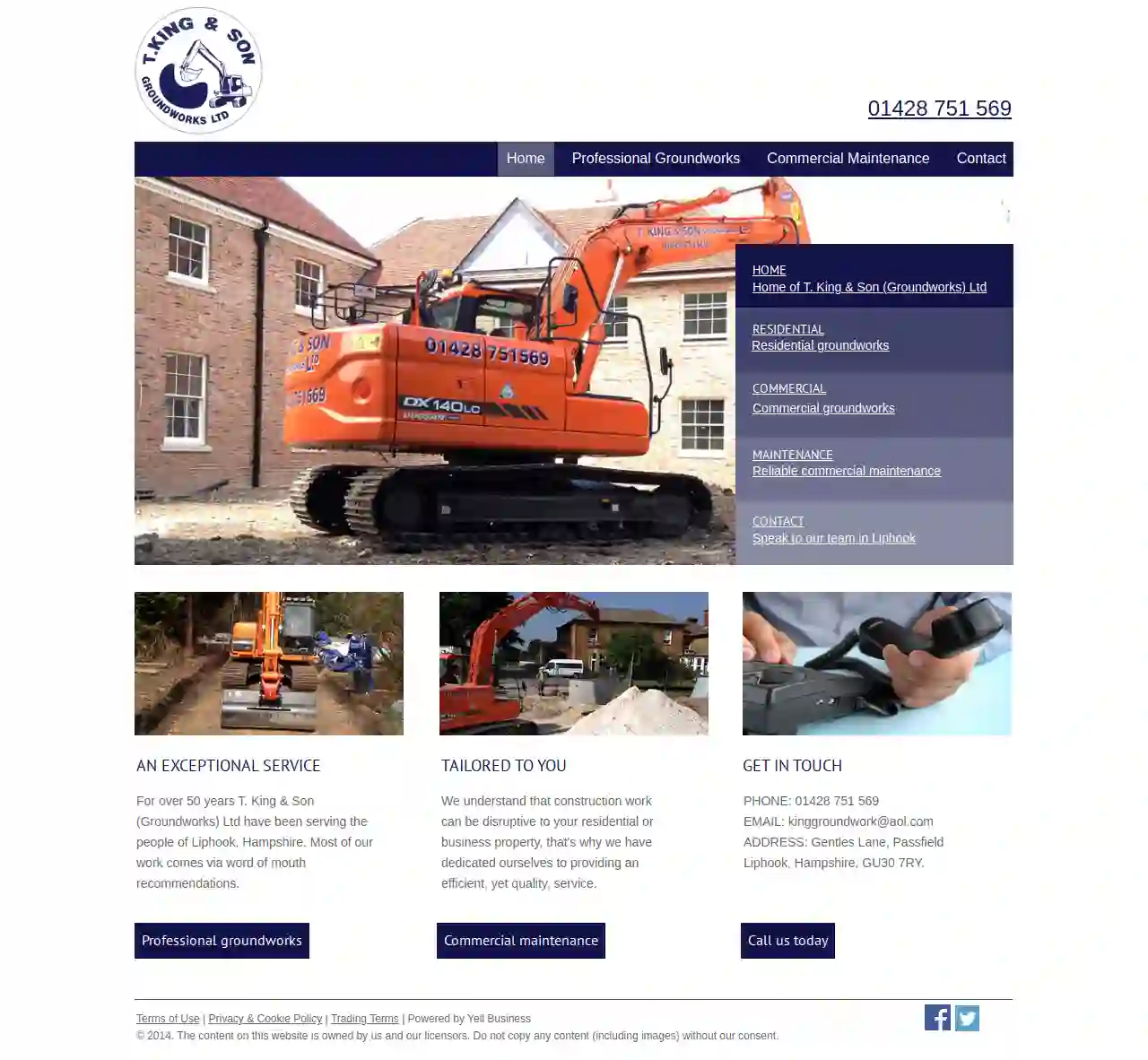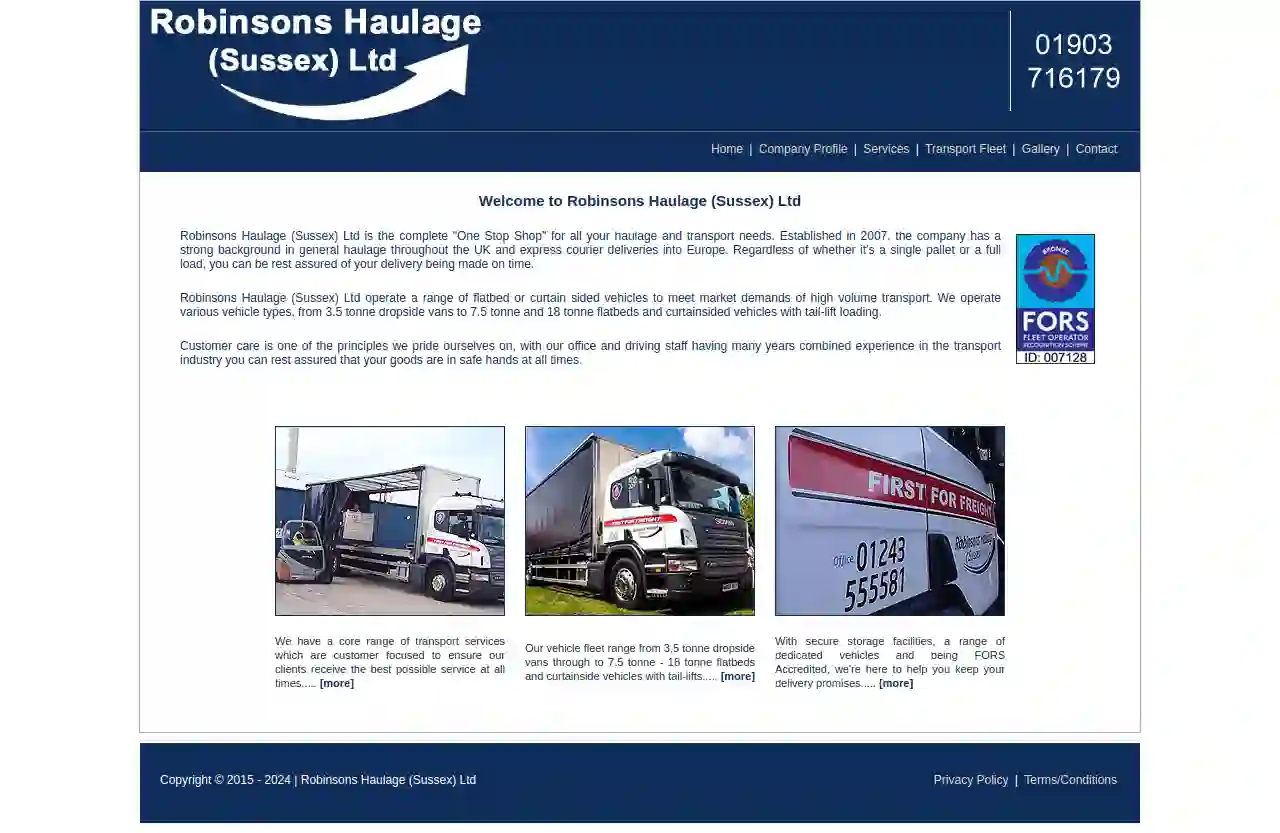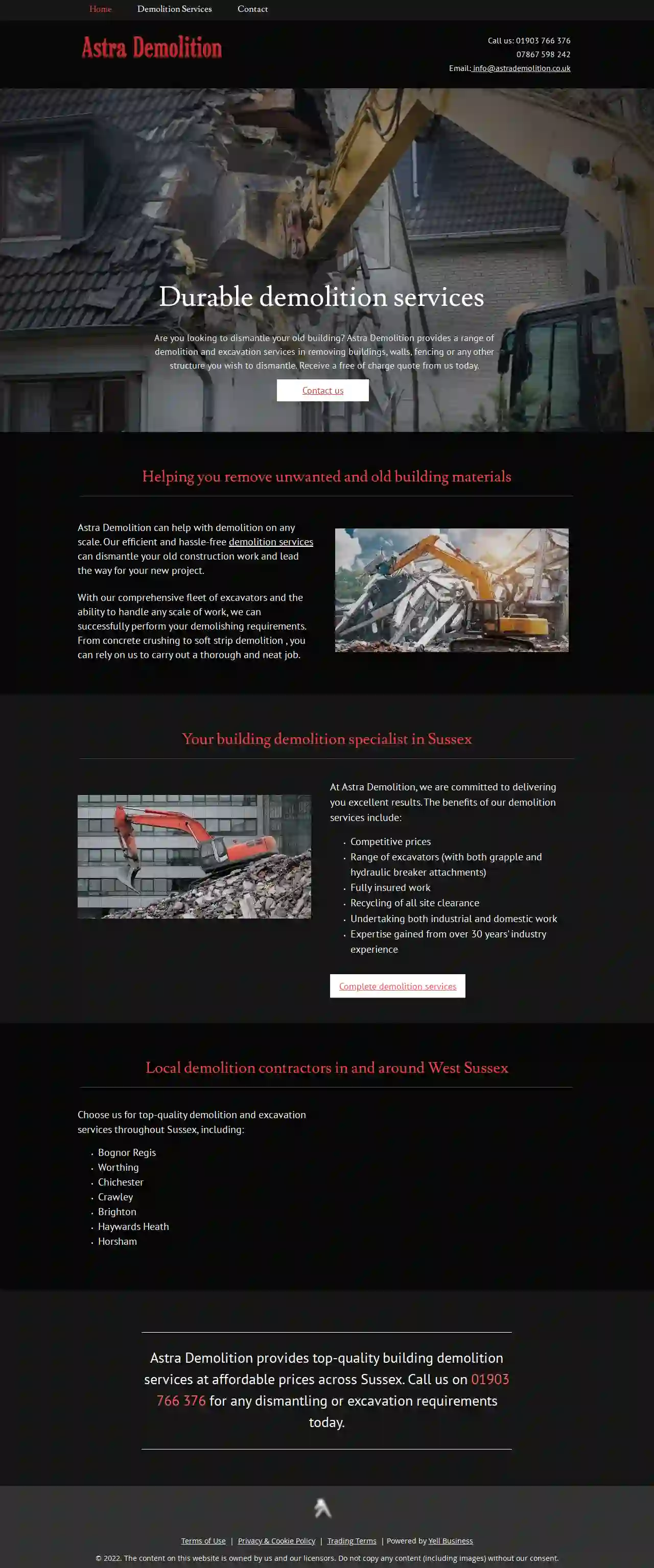Excavation Contractors East Preston
Find the best Land Excavation in East Preston
Get multiple Excavation Contractor quotes for your project today! Compare profiles, reviews, accreditations, portfolio, etc... and choose the best offer.

T King & Son Groundwork Ltd
Gentles Lane, Passfield, Liphook, GU30 7RY, GBT. King & Son (Groundworks) Ltd: Your Trusted Groundworks Partner in Hampshire For over 50 years, T. King & Son (Groundworks) Ltd has been a leading provider of groundworks services in Liphook, Hampshire. We've built a strong reputation for delivering exceptional quality and efficiency, earning the trust of countless satisfied customers. Our commitment to excellence is evident in every project we undertake, from residential to commercial groundworks and maintenance. We understand that construction work can be disruptive, which is why we prioritize minimizing disruption and delivering projects on time and within budget. Our team of skilled professionals is dedicated to providing a seamless and hassle-free experience for our clients. Whether you're building your dream home, expanding your business, or need reliable commercial maintenance, T. King & Son (Groundworks) Ltd is your trusted partner. We're committed to exceeding your expectations and delivering results that stand the test of time.
- Services
- Why Us?
- Gallery
Get Quote
Central Plant Hire
4.937 reviewsHolmbush Farm, Crawley Road, Holmbush Farm Crawley Road Faygate Horsham West Sussex, Horsham, RH12 4SE, GBCentral Plant Hire is a leading provider of plant and digger hire in West Sussex and Surrey. We offer a wide range of equipment to suit all your needs, from mini diggers to dumpers and attachments. We are committed to providing our customers with the highest quality equipment and service. Our team is experienced and knowledgeable, and we are always happy to answer your questions. We offer competitive rates and flexible hire options to suit your budget. We are proud to be a local business, and we are committed to supporting our community. We are a member of the Construction Industry Federation (CIF) and we are fully insured.
- Services
- Why Us?
- Accreditations
- Gallery
Get Quote
Robinsons Haulage Sussex Ltd
4.913 reviewsArea 3, Bairds Business Park, Hobbs New Barn, Bairds Business Park Hobbs New Barn Gravetts Lane, Climping West Sussex, Climping, BN17 5RX, GBAbout Robinsons Haulage (Sussex) Ltd Robinsons Haulage (Sussex) Ltd is a well-established haulage and transport company, founded in 2007. We've built a strong reputation for providing reliable and efficient services throughout the UK and Europe. Whether you need to move a single pallet or a full load, you can trust us to deliver on time and with the utmost care. We've grown from a single 3.5 tonne van to a fleet of vehicles ranging from 3.5 tonne dropside vans to 7.5 tonne and 18 tonne flatbeds and curtainsided vehicles with tail-lift loading. This allows us to cater to a wide range of transport needs, ensuring we have the right vehicle for every job. Customer satisfaction is at the heart of everything we do. Our team, with years of combined experience in the transport industry, is dedicated to providing exceptional service. We take pride in our commitment to safety and security, ensuring your goods are in safe hands at all times. We're proud to be FORS (Bronze) Accredited, demonstrating our commitment to safety, efficiency, and environmental responsibility. Our experienced and well-trained staff are committed to providing our clients with the highest level of service, keeping them informed every step of the way.
- Services
- Why Us?
- Accreditations
- Gallery
Get Quote
Arundels Construction
54 reviews13 The Cape, Littlehampton, West Sussex, BN17 6PL, GBArundels Construction Ltd Based in West Sussex, Arundels Construction Ltd has built a lasting reputation as a company of general and new home builders. With high-end services and an attractive pricing policy that can’t be beaten by any of our competitors, we transform properties in Bognor Regis, Chichester, Worthing and locations across the surrounding areas. About Arundel Builders With a sizeable portfolio of repeat customers who trust our general and new home builders completely, Arundels Construction Ltd will deliver a stress-free project to exceed your expectations. The procurement of quality materials from a trusted supplier network, coupled with our ability to take on installation and electrical work, has seen our company build a first-class reputation for its standards of workmanship and approach to superior customer service. We carry the required liability insurances, offer guarantees of between 15 and 25 years on our completed work, and have a perfect “10” rating on the Checkatrade website where our own customers review our projects. What Sets Us Apart Where we differ from other builders is in our ability to manage a project from the design stage all the way through to completion. Arundels Construction Ltd can include architectural work, engineering calculations and private building inspections in your package, which we adapt to your personal requirements.
- Services
- Why Us?
- Testimonials
- Gallery
Get Quote
Astra Demolition
51 reviewsWorthing, GBDurable demolition services Are you looking to dismantle your old building? Astra Demolition provides a range of demolition and excavation services in removing buildings, walls, fencing or any other structure you wish to dismantle. Receive a free of charge quote from us today. Helping you remove unwanted and old building materials Astra Demolition can help with demolition on any scale. Our efficient and hassle-free demolition services can dismantle your old construction work and lead the way for your new project. With our comprehensive fleet of excavators and the ability to handle any scale of work, we can successfully perform your demolishing requirements. From concrete crushing to soft strip demolition, you can rely on us to carry out a thorough and neat job. Your building demolition specialist in Sussex At Astra Demolition, we are committed to delivering you excellent results. The benefits of our demolition services include: Competitive prices Range of excavators (with both grapple and hydraulic breaker attachments) Fully insured work Recycling of all site clearance Undertaking both industrial and domestic work Expertise gained from over 30 years' industry experience Complete demolition services Local demolition contractors in and around West Sussex Choose us for top-quality demolition and excavation services throughout Sussex, including: Bognor Regis Worthing Chichester Crawley Brighton Haywards Heath Horsham Astra Demolition provides top-quality building demolition services at affordable prices across Sussex. Call us on 01903 766 376 for any dismantling or excavation requirements today.
- Services
- Why Us?
- Gallery
Get Quote
Dancy Building Contractors Limited
55 reviewsUnit 1, The Old Dairy, Steyning, BN44 3DZ, GBDancy Building Contractors: Modern Building, Traditional Values Dancy Building Contractors is a reputable and experienced building company based in Steyning, West Sussex. We are committed to delivering high-quality building services with a focus on traditional values and modern construction techniques. Our team of skilled professionals is dedicated to providing exceptional craftsmanship and customer service, ensuring your project is completed to the highest standards. We understand that building projects can be complex and require careful planning and execution. That's why we take a collaborative approach, working closely with our clients to understand their needs and vision. We provide clear communication, transparent pricing, and a commitment to delivering projects on time and within budget. Whether you're planning a home extension, loft conversion, or a complete new build, Dancy Building Contractors has the expertise and experience to handle your project with confidence. We are proud of our reputation for quality, reliability, and customer satisfaction. Contact us today to discuss your building project and let us help you bring your vision to life.
- Services
- Why Us?
- Gallery
Get Quote
M.G Construction Limited
Findon Court, Findon Road, Findon, BN14 0RA, GBYOUR LOCAL BUILDING AND CONSTRUCTION SPECIALISTS MG Construction offers reliable services of high quality at an affordable price. With more than 20 years of experience, we cover everything from new home builds to hard landscaping. If you need a dependable team of builders to assist on a project in the West Sussex area, look no further than MG Construction. Located in Worthing, we can easily access all parts of the county including Lancing and Steyning. Leave structural work, property refurbishments and home renovations in our capable hands, or add extra living space to a home with one of our property extensions, loft conversions or garage conversions. The choice is always up to you. MG Construction offers a project management service where we handle all aspects of the job from the conceptual stages through to handover. We can supply your project with builders, carpenters and all manual trades, which helps us maintain tight control over who is onsite and what happens onsite. All work undertaken complies with the current UK Building Regulations, and we trade with appropriate levels of employer and public liability insurance. Please contact us to arrange a survey, consultation and written quotation.
- Services
- Why Us?
- Testimonials
- Gallery
Get Quote
Coastline Drains
4.67 reviewsUnit 3, Littlehampton Marina, Ferry Road, Littlehampton, West Sussex, BN17 5DS, GBWelcome to Coastline Drains We strive to be the best and the most competent, efficient, and competitive drainage company in the area. Your Drainage Experts We strive to be the best and the most competent, efficient, and competitive drainage company in the area. The services that we offer are always executed using fully experienced engineers that will always go "the extra mile" to give complete customer satisfaction. We also believe that we are the most competitive in the area and we pledge to beat ANY written quotation for repair/replacement works. About Coastline Drains Coastline Drains was formed in 2000 as a family business and since this time we have constantly delivered the most competitive and comprehensive service in the area. Our reputation is the envy of our competitors who often try to replicate our professionalism, dedication, honesty and integrity (and even our name!). The services that we offer are always executed using fully experienced engineers that will always go "the extra mile" to give complete customer satisfaction. We also believe that we are the most competitive in the area and we pledge to beat ANY written quotation for repair/replacement works. Our Mission Statement To be totally transparent about our low fixed pricing structure To keep the customer fully informed throughout any and all works To maintain our efficiency, integrity, honesty, reliability and professionalism To strive to eclipse our competitors in everything we do and the way we operate Quite simply, we strive to be the best and the most competent, efficient, and competitive drainage company in the area Our Current client list Local Authorities Housing Associations Residential Letting Agents Commercial Letting Agents Facility Management Companies Property Management Companies Schools and Colleges Leisure Centres Businesses Private domestic dwellings
- Services
- Why Us?
- Testimonials
- Gallery
Get Quote
Horsham Landscaping Specialists
551 reviewsHorsham, GBAbout Us Horsham Landscaping Specialists was founded by our owner, James. With over a decade of experience in the industry, James possesses a deep passion and keen eye for detail when it comes to garden design and construction. Our entire company is built upon a team with a strong work ethic and a shared passion for landscaping, always striving to deliver the highest quality results. This dedication has fueled our rapid growth, allowing us to assemble a team of dedicated landscapers serving both residential and commercial clients across the UK. Based in the Surrey Hills, Horsham, we proudly serve customers in the local and surrounding areas, including Crawley, Haywards Heath, Kilwood Vale, Billingshurst, Gatwick, London, Brighton, and Worthing. We undertake all aspects of hard landscaping, including retaining walls, patios, driveways (block, loose stone, resin), decking, and specialize in artificial grass.
- Services
- Why Us?
- Our Team
- Testimonials
- Gallery
Get Quote
The Digger Man
53 reviewsWorthing, GBWELCOME TO THE DIGGER MAN Your Local excavating company Looking for a contractor to tackle a large-scale remodeling project, small garden alterations, groundwork for extensions, someone to help you create your own driveway or patio? The Digger Man is the best Excavating Contractor in Sussex, offering clients professional, reliable and safe contracting services. Whatever your needs thediggerman can help you and at a price that is unbeatable. Call me today and give your space the transformation it needs.
- Services
- Why Us?
- Our Team
- Gallery
Get Quote
Over 13,059+ Excavation Pros onboarded
Our excavation providers operate in East Preston and surrounding areas!
ExcavationHQ has curated and vetted Top Excavation Pros in and around East Preston. Find a top & reliable contractor today.
Frequently Asked Questions About Excavation Contractors
- Excavations Deeper Than a Certain Depth: This varies by jurisdiction, usually around 5 feet.
- Excavations Near Utilities: Digging near buried utilities (gas, water, electric) often requires permits and utility locates to prevent damage.
- Excavations Affecting Public Property: Projects impacting sidewalks, roads, or other public areas typically require permits.
- Excavations in Environmentally Sensitive Areas: Projects in wetlands, floodplains, or other sensitive areas might need special permits.
- Trench Collapses: Unstable trench walls can cave in, posing a severe risk to workers. Proper shoring and sloping are crucial safety measures.
- Utility Damage: Striking underground utilities (gas, water, electric) can cause leaks, explosions, or electrocution. Accurate utility locates and careful digging are essential.
- Falling Objects: Materials or equipment falling into excavations can injure workers. Securing work areas and using appropriate safety gear is vital.
- Equipment Accidents: Operating heavy machinery involves risks of rollovers, collisions, or mechanical failures. Trained operators and proper equipment maintenance are critical.
- Environmental Hazards: Excavated soil might contain hazardous materials (asbestos, lead). Proper testing and disposal procedures are necessary.
- Soil Type and Stability: Stable, cohesive soils allow for deeper excavations than loose or unstable soils.
- Groundwater Level: Excavations below the water table require dewatering techniques to manage water intrusion.
- Equipment and Resources: The size and capabilities of excavation equipment influence the achievable depth.
- Safety Regulations: OSHA and other safety regulations impose limitations on trench depths without proper shoring or sloping.
- Project Requirements: The purpose of the excavation (basement, pool, foundation) determines the necessary depth.
- Project Type and Size: Ensure the contractor has experience handling projects similar to yours in scale and complexity.
- Reputation and Reviews: Check online reviews and testimonials, and request references from previous clients.
- Licensing and Insurance: Verify that the contractor is properly licensed and insured to protect you from liability.
- Equipment and Resources: Confirm that they have the necessary equipment and resources for your project's needs.
- Communication and Transparency: Choose a contractor who communicates clearly, provides detailed estimates, and keeps you informed throughout the project.
- Safety Record: Inquire about their safety protocols and track record to ensure a safe work environment.
- Price: While price is important, it shouldn't be the only deciding factor. Balance affordability with experience, reputation, and quality of service.
Do I need a permit for excavation?
What are the risks associated with excavation?
How deep can you excavate?
How do I choose the right excavation contractor for my project?
Do I need a permit for excavation?
- Excavations Deeper Than a Certain Depth: This varies by jurisdiction, usually around 5 feet.
- Excavations Near Utilities: Digging near buried utilities (gas, water, electric) often requires permits and utility locates to prevent damage.
- Excavations Affecting Public Property: Projects impacting sidewalks, roads, or other public areas typically require permits.
- Excavations in Environmentally Sensitive Areas: Projects in wetlands, floodplains, or other sensitive areas might need special permits.
What are the risks associated with excavation?
- Trench Collapses: Unstable trench walls can cave in, posing a severe risk to workers. Proper shoring and sloping are crucial safety measures.
- Utility Damage: Striking underground utilities (gas, water, electric) can cause leaks, explosions, or electrocution. Accurate utility locates and careful digging are essential.
- Falling Objects: Materials or equipment falling into excavations can injure workers. Securing work areas and using appropriate safety gear is vital.
- Equipment Accidents: Operating heavy machinery involves risks of rollovers, collisions, or mechanical failures. Trained operators and proper equipment maintenance are critical.
- Environmental Hazards: Excavated soil might contain hazardous materials (asbestos, lead). Proper testing and disposal procedures are necessary.
How deep can you excavate?
- Soil Type and Stability: Stable, cohesive soils allow for deeper excavations than loose or unstable soils.
- Groundwater Level: Excavations below the water table require dewatering techniques to manage water intrusion.
- Equipment and Resources: The size and capabilities of excavation equipment influence the achievable depth.
- Safety Regulations: OSHA and other safety regulations impose limitations on trench depths without proper shoring or sloping.
- Project Requirements: The purpose of the excavation (basement, pool, foundation) determines the necessary depth.
How do I choose the right excavation contractor for my project?
- Project Type and Size: Ensure the contractor has experience handling projects similar to yours in scale and complexity.
- Reputation and Reviews: Check online reviews and testimonials, and request references from previous clients.
- Licensing and Insurance: Verify that the contractor is properly licensed and insured to protect you from liability.
- Equipment and Resources: Confirm that they have the necessary equipment and resources for your project's needs.
- Communication and Transparency: Choose a contractor who communicates clearly, provides detailed estimates, and keeps you informed throughout the project.
- Safety Record: Inquire about their safety protocols and track record to ensure a safe work environment.
- Price: While price is important, it shouldn't be the only deciding factor. Balance affordability with experience, reputation, and quality of service.